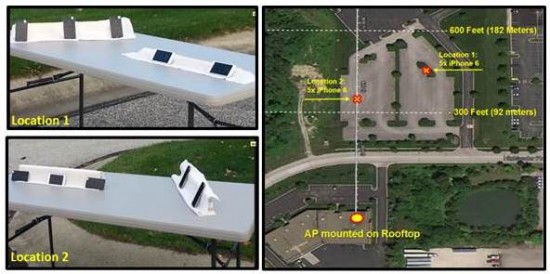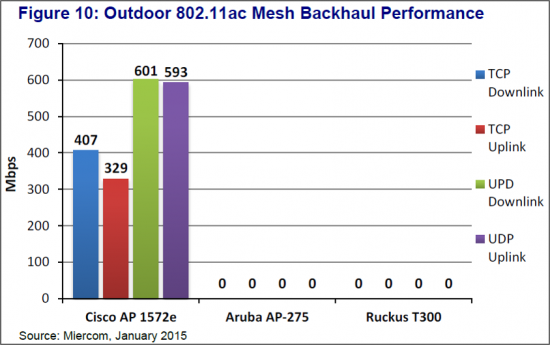The brisk inflation of 802.11ac in the Wi-Fi industry is evident from the large stream of wireless products entering the market with a stamp of the latest IEEE wireless standard. With that said, the Outdoor Wi-Fi Market is certainly not staying behind to join the 802.11ac bandwagon either. Cisco recently launched industry’s first 4×4, three spatial streams outdoor 802.11ac access point – Aironet 1570 series AP.
Taking into consideration an outdoor environment’s lively nature with the least multipath opportunities, and the presence of trees, high rises, and open spaces, it’s crucial to have a robust wireless solution to achieve the true benefits of 802.11ac. Miercom’s recent report helps find out the answer to the most ideal outdoor 802.11ac solution question. A comprehensive performance analysis on 802.11ac Outdoor Access Points, this third party vendor test report comprises of throughput performance, consistency and feature tests for flagship outdoor access points from three vendors including Cisco AP1572, Aruba AP275, and Ruckus APT300.
The report encompasses four major tests which provide an outlook of the performance capabilities of each access point in a real world environment. Let’s take a look at some of the highlights from each test analysis.
Outdoor Rate vs Range Test
The classic range testing to analyze the performance of the clients based on the distance from the AP. Two of the most popular smartphones: Samsung Galaxy S4 (1 Spatial Stream) and Galaxy S5 (2 Spatial Streams) were tested at close, mid and long ranges to see how 802.11ac performance is impacted in an outdoor setting.
Cisco 1572 AP’s 4×4:3 antenna architecture, combined with implicit & explicit beamforming, and the highest transmit power allowed by the FCC for an outdoor AP, directly complements to sustaining higher 802.11ac data rates even at longer ranges. Communicating at higher data rates allows the clients to transmit and receive more data traffic faster, thus obtaining a higher throughput performance. This theory can be realized from the 1000 feet mark in the graph above where Cisco 1572 delivers five times the performance as compared to either Ruckus or Aruba with a single spatial stream Galaxy S4 client.
Outdoor Multi-Client Performance & Consistency
Achieving high performance at various distances matters, but only when it’s backed by consistency. To test the consistency factor, two sets of Apple’s recent 802.11ac capable iPhone 6 smartphones, a group of five in each set, were placed in the same outdoor environment. Five iPhone 6 were placed on a table at different locations at 350 feet and 500 feet as seen in the diagram below.
The idea behind this test was to understand how consistently the AP would deliver in a condition where multiple users are simultaneously trying to connect and surf from various positions in an outdoor setting- a fairly common happening for an outdoor café, downtown area, a university or a parking lot. Using multiple devices of the same make and model – iPhone 6, allowed to keep a steady capability of the user devices and minimize inconsistency.
Looking at the test results, you can quickly grasp that both Aruba and Ruckus flagship outdoor APs suffer from either inconsistency or poor performance, or a combination of both. Cisco AP1572 proved to be significantly consistent in overall performance regardless of the distance or number of the grouped iPhone devices.
Outdoor Mesh 80-MHz Backhaul Performance
Mesh networks are eminent for customers offering outdoor Wi-Fi in order to manage critical business needs or technical requirements. Be it extending your wireless networks with minimum infrastructure costs or simply bridging two building networks sans running additional cables, it can be effectively figured out using mesh.
The third test case was based on mesh bridging where two networks are bridged with the root and mesh access points located 1000 feet (300 meters) apart. The objective was to test over-the-air performance of the 802.11ac backhaul connected on 80MHz wide network.
While setting up the testbed, it was soon realized that neither Aruba nor Ruckus offered Mesh features on their flagship outdoor access points. This came as quite a surprise since mesh is one of the most sought-after features when it comes to outdoor networking. Nevertheless, Miercom and team went ahead with the tests as planned to see how 802.11ac mesh performs in a real outdoor environment.
Cisco offered a substantial 600+ Mbps connectivity for UDP downlink and 400+ Mbps for TCP downlink over the backhaul network, which at a distance of 1000 feet are impressive numbers for any network operator to convincingly offer bridged networks at high speeds. Unfortunately, due to the lack of the mesh feature, we could not compare how the Ruckus and Aruba counterparts measured up in the same mesh arena.
High Client Density Performance – 100 Clients
Finally, pitching these tough APs in one of the most dreaded situations– hundred Wi-Fi hungry clients, all at once. When you put together a pure mix of real world clients consisting of laptops (macs and windows), and iPads, having a protocol mix of 11n and 11ac along with a MIMO mix of two spatial and three spatial stream clients, you get one aggressive multi-client situation – something every vendor tries to design and build their APs to conquer. Well maybe not just every.
With a 70:30 distribution on 5GHz and 2.4GHz respectively, and all the best practices checked, it was down to how each AP handled a multi-client scenario starting from ten clients to under a heavy stress of 100 clients in order to reveal the capable Wi-Fi performance characteristics of the access points.
Aruba AP275 starts struggling beyond the 30 clients mark while Ruckus APT300 offered inadequate performance right from scratch. Cisco AP1572 comes laden with HDX technology along with dedicated CPU for each radio which allows for highly scalable scheduling capabilities to achieve an exceptional performance in a high stress multi-client environment as seen in the graph above. The performance that Cisco delivered for 100 clients (300 Mbps) remarkably equals to Aruba’s performance with 40 clients, which means more than twice the number of clients can be supported on the Cisco AP at same performance level. Similarly, Ruckus offers the same performance with less than just 20 clients – a massive five times lower client count than Cisco to get the same performance.
To get more details on the tests and performance results, download the full Miercom Report and find out why Cisco 1572 series outdoor access point is the most optimally designed 802.11ac Outdoor AP for any outdoor vertical.








What antennas were used on the 1572e?
Cisco Aironet Dual-Band Omnidirectional Antenna AIR-ANT2568